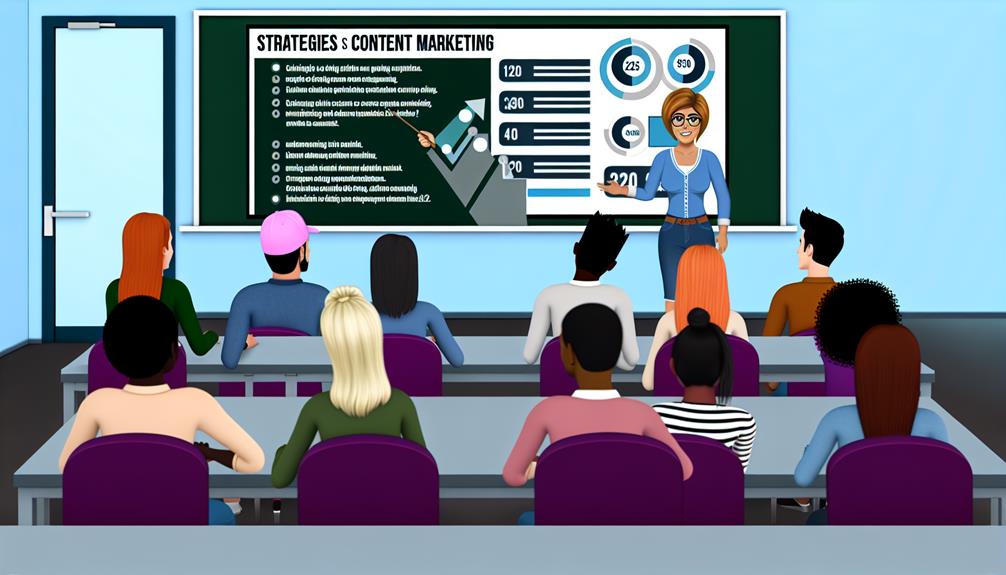In the world of higher education, the pursuit of academic excellence often sits at odds with the need for effective marketing. You're striving to attract and retain students, yet it's no longer enough to simply offer a quality education. Today's students demand engagement; they want to be captivated, involved, and made to feel a part of something bigger.
So how can you, as an institution, meet these demands? The answer lies in tailoring your content marketing strategies to not only reach your audience but to engage them deeply. But what does this look like in practice? And how can you measure its success?
Let's explore.
Key Takeaways
- Content personalization and audience segmentation are key strategies for boosting student engagement in higher education content marketing.
- Understanding the preferred social media platforms of the target audience and creating content that resonates with them is crucial for increasing student engagement.
- Incorporating interactive content such as virtual tours and gamification techniques can enhance student engagement and improve the learning experience.
- Utilizing SEO techniques and measuring engagement metrics are important for improving online visibility and tailoring strategies for maximum impact in higher education content marketing.
Understanding Content Marketing in Higher Education

To truly harness the power of content marketing in higher education, you first need to grasp what it involves and why it's critical for your institution's success. It's about creating and sharing valuable content tailored to attract, educate, and convert your target audience. Key strategies such as Content Personalization and Audience Segmentation play a significant role.
Content Personalization is about tailoring your content to meet the unique needs of your audience. It's not a one-size-fits-all approach, rather it's about understanding your audience's interests, needs, and expectations. It's about creating content that resonates with them, that speaks to them on a personal level.
Audience Segmentation, on the other hand, is about dividing your audience into distinct groups based on shared characteristics such as age, major, location, interests, and more. By segmenting your audience, you can create more relevant and personalized content, which can lead to higher engagement and conversion rates.
Leveraging Social Media Platforms
Harnessing the vast potential of social media platforms can significantly amplify your institution's content marketing impact. In today's digital age, you can't afford to ignore the power of social media in engaging students.
When it comes to platform selection, you've to be strategic. Not all platforms yield the same results, so you'll need to:
- Understand your target audience: Are they more active on Instagram, Facebook, or LinkedIn?
- Identify the type of content that resonates with your audience: Are they more inclined towards visual content (photos, videos), or do they prefer text-based posts?
- Analyze your competitors: Which platforms are they using and what kind of content are they sharing?
Don't underestimate the power of influencer collaborations. Students resonate with the influencers they follow. Partnering with influencers can:
- Enhance your institution's credibility.
- Boost your reach and engagement.
- Increase your enrollment rates.
Incorporating Interactive Content

While you're making waves on social media, don't forget the potential of interactive content in your higher education marketing strategy. It's a dynamic tool that can significantly boost student engagement.
One powerful way to incorporate interactive content is through virtual tours. They offer prospective students an immersive experience, allowing them to explore your campus without leaving their homes. It's not just about showcasing the physical space; it's also an opportunity to highlight your institution's culture, values, and unique offerings.
Another innovative method is the use of gamification techniques. They turn learning into a fun, competitive activity, which can increase student participation and retention. You could introduce quizzes, puzzles, or challenges related to your courses, with rewards for top performers. It's a great way to make the learning process more engaging and enjoyable.
Incorporating interactive content isn't just about being trendy; it's about meeting the students where they're and enhancing their learning experience. So, don't be afraid to experiment and innovate. With the right approach, you'll see a significant improvement in student engagement. And in the competitive world of higher education marketing, that could make all the difference.
Utilizing SEO for Student Engagement
In the digital age, you can't overlook the power of Search Engine Optimization (SEO) in engaging and attracting prospective students. This strategy helps to increase your school's visibility online. By utilizing SEO tools and implementing keyword analysis, you're ensuring that your content reaches the right audience- students who are actively seeking educational opportunities like yours.
Here are some ways you can maximize your SEO efforts:
- Keyword Analysis
- Research relevant keywords that prospective students are likely to search for.
- Use these keywords strategically throughout your content.
- Monitor and adjust your keyword strategy based on results.
- Using SEO Tools
- Use tools like Google Analytics to track your website's performance.
- Implement SEO plugins on your website to help you optimize your content.
- Utilize tools that suggest related keywords to broaden your reach.
- Creating SEO-friendly content
- Write engaging, high-quality content that naturally incorporates your keywords.
- Regularly update your content to keep up with changes in trends and algorithm updates.
- Create backlinks to your content to boost its visibility and authority.
Case Study: Successful Engagement Strategies

Now that you've got a handle on SEO for student engagement, let's explore some real-world examples of successful engagement strategies in action.
First, we'll look at how universities are leveraging engagement technology to boost interaction. A prominent example is the University of Michigan, which uses an app to push notifications about campus events, clubs, and resources. This app has increased student involvement by 45%! Technology not only provides a convenient platform for students to engage but also offers valuable data for universities to analyze and improve their strategies.
Next, let's discuss incentive programs. These can be a game-changer in motivating students to participate. For instance, Arizona State University implemented a point-based rewards system for student engagement. Students can earn points for attending events, participating in clubs, or utilizing campus resources, and later redeem these points for perks like priority registration or discounts at the campus store. This has resulted in a 60% increase in student event attendance.
These case studies illustrate how innovative approaches, like engagement technology and incentive programs, can significantly boost student engagement. As you formulate your strategies, consider how you can adapt these successful models to your institution's unique needs.
Measuring and Improving Engagement Metrics
To keep your engagement strategies on track, you'll need to measure their effectiveness and make necessary improvements. Engagement analytics play a crucial role in this process. Analytics provide insights into how students interact with your content, enabling you to tailor your strategies for maximum impact.
Here's how you can use engagement analytics and personalized outreach to boost student engagement:
- Track Engagement Metrics: Measure key indicators such as click-through rates, time spent on pages, and social media interactions. These metrics provide a clear picture of what's working and what's not. You can then adjust your strategies accordingly.
- User Surveys: To understand the 'why' behind the metrics, conduct surveys. This gives you direct feedback from students about their preferences and expectations.
- A/B Testing: Test different versions of your content to see which resonates the most with students. This data-driven approach ensures your strategies are effective.
- Implement Personalized Outreach: Use the data collected to personalize your outreach efforts. Tailor your content, emails, and social media posts to meet the needs and interests of individual students. This personal touch can significantly boost engagement and foster a sense of connection with your institution.
Conclusion
You might be thinking, 'Is it worth investing time and energy into a content marketing strategy for higher education?' Absolutely.
Imagine a campus buzzing with engaged students, drawn in by your captivating content.
Harnessing social media, interactive content, and SEO can transform your student engagement.
And remember, with the right metrics, it's possible to track and refine your strategy.
So, why not give higher education content marketing a shot?
The results could truly be game-changing.




